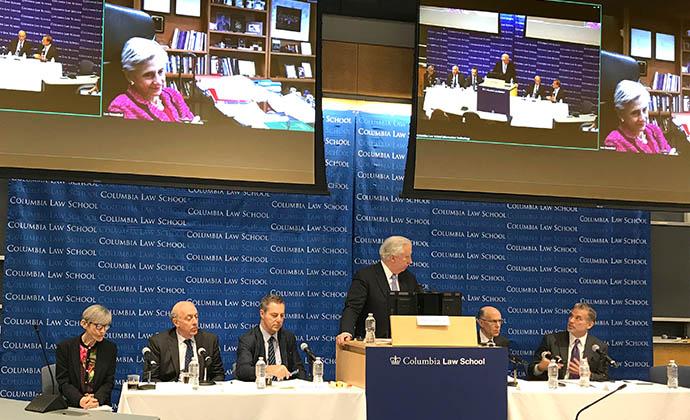NFL Concussion Case Takes Center Stage at Columbia Law Conference
Scholars, judges, and practitioners examine the evolution and state of class actions, including the jurisprudence of former U.S. Court of Appeals Judge Richard Posner.
One of the highest-profile class-action cases in recent years was filed by former players against the National Football League. In 2011, 73 retired NFL players filed the class-action lawsuit claiming that the league failed to properly protect them from head injuries or disclose the chronic, long-term risks associated with them.
On March 2, the landmark case—and its many thorny legal issues—was the subject of a lively panel discussion at a Columbia Law School conference examining the outsized impact of former U.S. Court of Appeals Judge Richard Posner on class-action jurisprudence. Lawyers for both the NFL and the eventual class of more than 20,000 former players said that the resulting settlement—in which the league will pay an uncapped amount estimated at $1 billion—was due to the careful oversight of Judge Anita B. Brody ’58 of the U.S. District Court for the Eastern District of Pennsylvania.
“The judge played an incredibly active role in superintending this case,” said Brad S. Karp, the NFL’s lead attorney who is chairman of Paul, Weiss, Rifkind, Wharton & Garrison.
The daylong conference also included sessions on class certification and settlement procedure and was organized by John C. Coffee Jr., the Adolf A. Berle Professor of Law at Columbia Law School and director of its Center on Corporate Governance.
One of the highlights of the conference was a lunchtime talk with former clerks of Posner: Columbia Law School Professors Kathryn Judge, Edward R. Morrison, and Tim Wu as well as former Columbia Law Professor Scott Hemphill. One of the nation’s leading appellate judges, Posner has authored more than 40 opinions on class-action cases and shaped the doctrine for decades.
At the highly anticipated NFL panel moderated by Coffee, Brody sat front and center, listening attentively to NFL attorney Karp; the players’ attorneys Chris Seeger, Samuel Issacharoff, and Elizabeth J. Cabraser; and expert witness Robert Klonoff. U.S. District Judge Lee H. Rosenthal for the Southern District of Texas, who was not involved in the case, participated by video and offered her perspective from having overseen many class actions. (Brody offered no commentary because she is still hearing motions in the case.)
Coffee asked panelists whether the case was appropriately structured as a class action or should have proceeded as a mass tort in which players are individually represented. The panelists compared the concussion case to Amchem v. Windsor, a 1997 ruling in which the U.S. Supreme Court severely curtailed the class action’s applicability to personal injury cases, basing its decision on conflicts between current and future class members.
Issacharoff said the parties in the NFL case looked “at where the law had moved” in the intervening years. Both sides ultimately decided that a concurring decision from Judge Anthony Joseph Scirica of the U.S. Court of Appeals for the 3rd Circuit (who participated in the conference earlier in the day and was also in the audience) had provided an opening for the players to proceed as a class.
Karp said the NFL, which “has historically engaged in scorched-earth litigation,” wanted to settle the case from the outset because “the risk of cognitive impairment as a result of playing professional football is one of those rare existential threats.” But he said a settlement would not have been possible without the closure inherent in a class resolution, in which participating members agree to give up future claims based on the alleged wrongdoing.
“I don’t think this case would have been settleable for the NFL if we weren’t able to secure something close to global peace,” he said.
The parties noted some of the extraordinary elements of the deal. It is uncapped; the court and the parties will retain jurisdiction over the matters for 65 years; and the NFL is required to consider future scientific evidence about diagnosing concussion-related injuries.
Although litigants and judges can try to craft similar oversight mechanisms in a mass tort, Rule 23 of the Federal Rules of Civil Procedure, which governs class actions, provides the best built-in mechanisms for doing so, explained Cabraser. Among other things, the rule provides for notice to potential class members about the nature of the suit and their rights within it.
“I think we are going to be seeing more long-term, complex personal injury and wrongful death cases going back to the future and utilizing Rule 23,” she said.
As for whether Posner, who retired from the bench last year, would have upheld the settlement on appeal, as the U.S. Court of Appeals for the 3rd Circuit did in 2016, the panelists insisted he would have.
“Absolutely,” Klonoff said. “Judge Posner’s teachings are consistent with everything done in this case.”
Still, the parties acknowledged that resolving the concussion case had not been easy, noting that Brody had rejected their first settlement agreement in part because it imposed a cap on total payments.
“It wasn’t always pleasant,” said Issacharoff. “Getting your handiwork thrown back in your face isn’t fun.”
Maybe not, but at least one member of the audience found that remark amusing. As Coffee looked at Brody, he noted: “The record will show the judge is smiling.”
###
Read News Coverage:
Law360: NFL, Class Attorneys Hash Out Concussion Deal's Pros and Cons
Bloomberg Big Law: NFL Class Action As Model for Future Mass Torts
Posted on March 26, 2018
